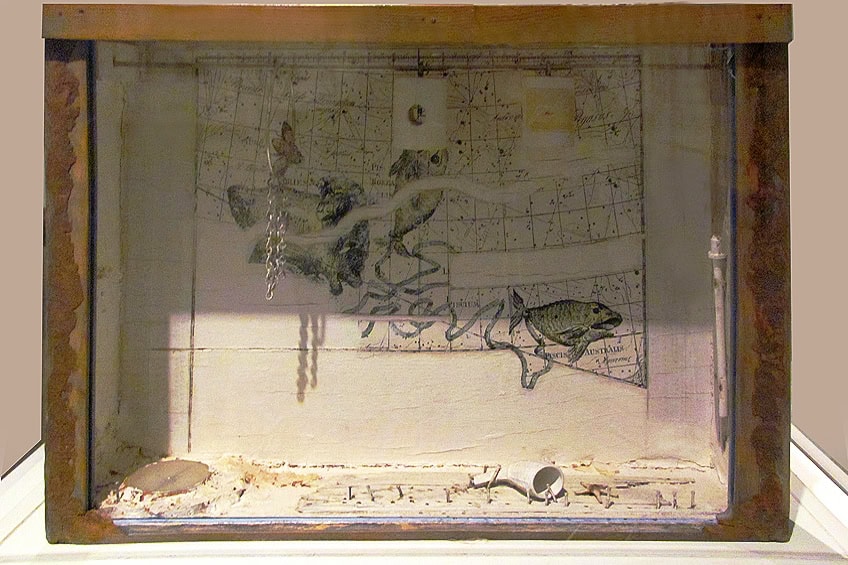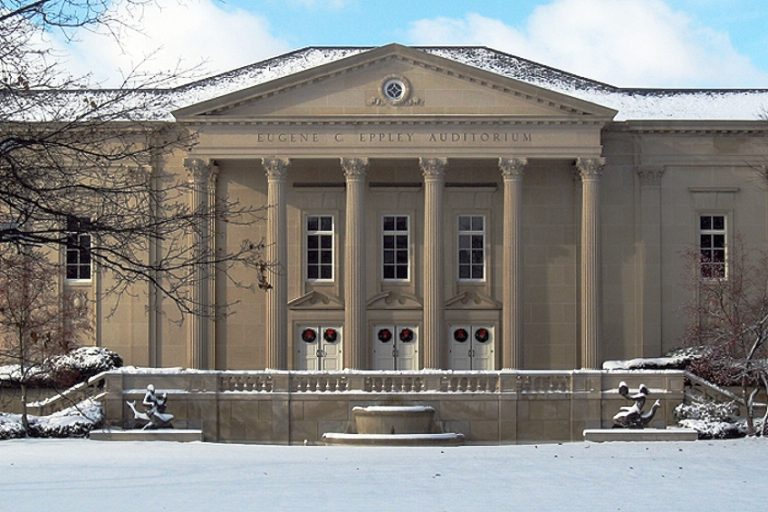Joseph Cornell – A Visionary in Miniature
Joseph Cornell was an innovative and influential American artist and sculptor, best known for his enchanting and meticulously crafted shadow boxes. Born on December 24, 1903, Cornell spent much of his life in relative seclusion in Queens, New York City. Despite his reclusive nature, he developed a unique artistic vision that drew from surrealism, assemblage, and a deep sense of nostalgia. His works often feature a collage-like assemblage of found objects, photographs, and ephemera, enclosed in glass-fronted boxes that evoke dreamlike worlds and delicate narratives. Cornell’s art invites viewers into intimate, contemplative spaces where memories and fantasies intertwine, cementing his legacy as a pioneering figure in 20th-century art.
Key Takeaways
- Joseph Cornell was an influential American visual artist and filmmaker.
- He was best known for his assemblage works and shadow boxes.
- His art, inspired by Surrealism, explored themes like childhood and memory.
Early Life and Inspirations
| Birth | December 24, 1903 |
|---|---|
| Death | December 29, 1972 |
| Place of Birth | Nyack, New York, United States |
| Genre of Work | Assemblage, collage, experimental film, and sculpture |
Joseph Cornell, a pioneering American artist born on December 24, 1903, revolutionized the art world with his distinctive assemblage works and unique shadow boxes. Known for creating poetic and surrealistic boxes, collages, and experimental films, Cornell crafted an original style that continues to inspire and influence artists today. Largely self-taught, he drew inspiration from Surrealism and used found objects to construct dream-like dioramas that evoke a sense of nostalgia and wonder. Cornell’s artistic journey began in New York, where he lived a reclusive life but maintained a profound inner world reflected through his art.

His works often incorporated themes of childhood, space, and ballet. Despite his shy and introverted nature, Cornell’s art found its way into significant exhibitions and collections, cementing his legacy as a seminal figure in 20th-century art. Cornell’s ability to transform ordinary, everyday objects into extraordinary pieces of artistic expression earned him acclaim as a master of assemblage. Through his innovative use of materials and his uncanny ability to create stories within confined spaces, he has left an indelible mark on the art community, making him a crucial figure in understanding the evolution of modern art.
Background and Education
Joseph Cornell was born on December 24, 1903, in Nyack, New York. He was the eldest of four siblings in a family with Dutch ancestry. His father worked as a textile designer while his mother had a background in teaching. The family lived in a working-class area, but circumstances changed when his father died of leukemia in 1917, leaving the family in financial difficulty.
Cornell attended Phillips Academy, an indicator of the family’s social aspirations despite their strained finances. He did not pursue higher education after high school, instead remaining largely self-taught. Moved by his mother’s Christian Science beliefs, his reflective nature influenced his work deeply, contributing to his later romantic and poetic styles.
Artistic Influences
Cornell was deeply inspired by the Surrealists and the avant-garde movements. He admired the work of artists who created dreamlike sequences and abstract concepts. The Romantic period also left a mark on him, evident in the poetic nature of his creations.
Cornell’s fascination with Victorian bric-a-brac and cabinets of curiosities is seen in his elaborate shadow boxes.
His work often incorporated discarded objects, reflecting his philosophy of finding beauty in the mundane. Objects like old maps, clay pipes, and marbles became central to his artistic narrative. Cornell’s style emerged as highly original, blending the historical with the contemporary in a thoughtful manner.
Accomplishments
Joseph Cornell is best known for his pioneering role in assemblage art. He created intricate shadow boxes that combined various elements in unexpected ways. These pieces reflect his meticulous nature and romantic imagination. Cornell also ventured into experimental filmmaking, producing works that included the same dreamlike qualities as his visual art.

His contributions extended beyond art; he influenced other artists with his unique process and vision. Cornell’s house on Utopia Parkway in Queens became a hub for artistic innovation. Living modestly, he achieved significant accomplishments that resonated within and beyond the art community, cementing his place as a pivotal figure in 20th-century American art.
Signature Works and Artistic Style
Joseph Cornell is celebrated for his innovative use of found objects and his distinctive approach to assemblage art. His work is renowned for its dream-like qualities and meticulous composition.
Boxes and Assemblages
Cornell’s most iconic creations are his glass-fronted boxes, often called shadow boxes. These pieces are curated with Victorian bric-a-brac, dime-store trinkets, old photographs, and other found elements, creating intricate, poetic theaters.
The Soap Bubble Set and Aviary Series exemplify his fascination with memory and fantasy.
In these works, Cornell used cast-off and discarded artifacts to build miniature worlds that evoke a sense of nostalgia and wonder. His ability to transform everyday objects into art forms resulted in a unique, recognizable style known as box construction.
Collages and Experimental Films
In addition to his assemblages, Cornell explored the realm of collages and experimental film. His most famous film, Rose Hobart, demonstrated his talent for avant-garde filmmaking. He repurposed footage from an old Hollywood movie, cutting and re-editing it to create a surreal and mesmerizing piece.
Cornell’s collages employed similar techniques, using cut-outs from magazines and books to craft new narratives and visual experiences. These works continued his practice of improvisation, adding layers of meaning through unexpected juxtapositions and compelling compositions.
His film and collage work both reflect his relentless curiosity and inventive spirit, further cementing his legacy as a pioneer in multiple artistic disciplines.
Career Highlights and Exhibitions
Joseph Cornell’s career was marked by numerous notable exhibitions and important collaborations. His unique approach to assemblage and his innovations in art brought him recognition in prestigious institutions and creative circles.
Prominent Displays and Museums
Joseph Cornell’s work has been extensively displayed in several renowned museums. The Smithsonian American Art Museum showcased Joseph Cornell: Navigating the Imagination, highlighting the breadth of his themes and providing new insights into his innovations. The Museum of Modern Art (MoMA) featured Cornell’s work in various exhibitions, underlining his status as a pioneer in assemblage.
MoMA’s permanent collection includes many of Cornell’s masterpieces, reflecting his importance in 20th-century American art.
The Metropolitan Museum of Art also recognizes Cornell’s contributions, often displaying his intricate shadow boxes and collages. Other galleries, such as Albright-Knox and the Pasadena Art Museum, have highlighted his oeuvre, allowing wider audiences to appreciate his meticulous craftsmanship and imaginative vision.
Collaborations and Relationships
Cornell maintained notable relationships and collaborations with celebrated figures in the art world. He was influenced by and collaborated with Surrealists like Marcel Duchamp, Salvador Dalí, and Max Ernst, which helped shape his distinctive artistic style. His cross-disciplinary engagement extended to filmmakers like Stan Brakhage, with whom he shared a deep interest in experimental cinema.

Cornell’s relationships went beyond professional circles, as he was also known to be friends with actress Lauren Bacall, enriching his artistic milieu. These interactions and collaborations expanded his creative horizons and cemented his place in the avant-garde movement.
Personal Life and Legacy
Joseph Cornell’s personal life was marked by his reclusiveness and devotion to family, which significantly influenced his art. His legacy endures in contemporary art, where his innovative assemblages and films continue to inspire artists and collectors.
Family and Personal Relationships
Joseph Cornell was born in Nyack, New York, as the eldest of four children. His brother, Robert, suffered from cerebral palsy, and Cornell took on significant caregiving responsibilities. His father’s untimely death when Cornell was thirteen led to the family relocating to Queens, New York. Cornell’s shyness and reclusive nature defined much of his adult life. He never married, though he formed platonic relationships with several women whom he found intellectually and artistically stimulating.
Influence on Contemporary Art
Cornell’s assemblage work, particularly his shadow boxes, have left a lasting impact on contemporary visual artists. He ingeniously combined everyday objects to create intricate, dream-like scenes that continue to captivate viewers. His later involvement in experimental filmmaking added another layer to his artistic influence, affecting not only visual artists but filmmakers as well.
Contemporary artists and designers still draw inspiration from Cornell’s ability to evoke emotion using found objects and his unique narrative style.
Legacy of Joseph Cornell Today
Today, Joseph Cornell’s work is celebrated and preserved through various institutions. The Joseph Cornell Study Center at the Smithsonian American Art Museum holds many of his pieces and personal effects. Museums in New York City and across the world regularly feature his works in both permanent collections and traveling exhibitions.

His contributions to the art world are also recognized by contemporary artists who cite him as a major influence in both their conceptual and practical approaches to art-making. Cornell’s legacy remains strong, bridging the gaps between painting, sculpture, and film.
Joseph Cornell’s legacy endures as a testament to the power of imagination and the beauty found in the mundane. His innovative shadow boxes, with their intricate layers and poetic resonance, continue to captivate and inspire viewers and artists alike. Cornell’s work transcends time, inviting us to explore the delicate interplay between memory and dream, reality and fantasy. By transforming everyday objects into magical realms, he reminds us of the potential for wonder and creativity in the world around us. As we reflect on his contributions to art, Cornell’s ability to evoke deep emotional responses through his enigmatic creations ensures his place as a pivotal figure in the history of modern art.
Frequently Asked Questions
How Did Joseph Cornell Influence the Assemblage Art Movement?
Joseph Cornell is regarded as a pioneer in the assemblage art movement. His work involved collecting and juxtaposing everyday objects to create intricate, dreamlike compositions. These pieces often drew on surrealist principles, making his art both innovative and influential among his contemporaries and future generations.
What Techniques Did Joseph Cornell Employ in His Collage Works?
Cornell’s collage works were marked by meticulous layering and careful selection of materials. He often used cutouts from magazines, photographs, maps, and various ephemera. His technique emphasized a sense of nostalgia and wonder, transforming ordinary items into intricate narratives that engaged the viewer’s imagination.
What Themes Are Prevalent in Joseph Cornell’s Box Sculptures?
Cornell’s box sculptures frequently explored themes such as memory, dreams, and the passage of time. He often incorporated elements of childhood, fantasy, and nature. The sense of isolation and poetic longing is evident in many of his works, reflecting his introspective and contemplative nature.
Isabella studied at the University of Cape Town in South Africa and graduated with a Bachelor of Arts majoring in English Literature & Language and Psychology. Throughout her undergraduate years, she took Art History as an additional subject and absolutely loved it. Building on from her art history knowledge that began in high school, art has always been a particular area of fascination for her. From learning about artworks previously unknown to her, or sharpening her existing understanding of specific works, the ability to continue learning within this interesting sphere excites her greatly.
Her focal points of interest in art history encompass profiling specific artists and art movements, as it is these areas where she is able to really dig deep into the rich narrative of the art world. Additionally, she particularly enjoys exploring the different artistic styles of the 20th century, as well as the important impact that female artists have had on the development of art history.
Learn more about Isabella Meyer and the Art in Context Team.
Cite this Article
Isabella, Meyer, “Joseph Cornell – A Visionary in Miniature.” Art in Context. July 8, 2024. URL: https://artincontext.org/joseph-cornell/
Meyer, I. (2024, 8 July). Joseph Cornell – A Visionary in Miniature. Art in Context. https://artincontext.org/joseph-cornell/
Meyer, Isabella. “Joseph Cornell – A Visionary in Miniature.” Art in Context, July 8, 2024. https://artincontext.org/joseph-cornell/.











